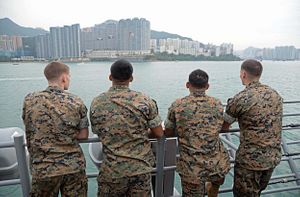The Wasp-class amphibious assault ship USS Bonhomme Richard and the San Antonio-class amphibious transport dock USS Green Bay arrived in Hong Kong for a port visit on September 29, according to a U.S. Pacific Command statement.
“The visit affords Sailors and Marines of both ships the opportunity to enjoy the culture and history of Hong Kong, and to build positive relationships with members of the Hong Kong community,” the statement reads.
The Hong Kong port call follows the participation of both vessels in this year’s Valiant Shield 2016 naval exercise, held from September 12-23 off the coast of Guam and around the Marianas Island Range Complex in the western Pacific Ocean (See: “US Navy to Hold Massive Naval Drill in Western Pacific”).
The naval exercise, held every other year since 2006, involved 18,000 military personnel, over 180 U.S. aircraft, and the nuclear-powered Nimitz-class aircraft carrier USS Ronald Reagan, based in Yokosuka Naval Base in Japan’s Kanagawa Prefecture and currently the U.S. Navy’s only forward-deployed aircraft carrier in the Asia-Pacific region. The USS Bonhomme Richard, USS Green Bay, and nine other surface warships also took part.
“We have encountered nothing but professional mariner behavior from the Chinese vessels we interacted with,” Rear Adm. Marc H. Dalton, the commander of Expeditionary Strike Group 7 visiting Hong Kong said, according to The Japan Times.
In April, the Chinese government canceled a scheduled port visit of the nuclear-powered aircraft carrier USS John C. Stennis without providing an explanation. As I reported then:
The nuclear-powered aircraft carrier had been conducting patrols in the South China Sea, launching hundreds of sorties while cruising the waters (See: “US Carrier Strike Group Arrives in South China Sea to Deter China”). The move was widely seen as a tit-for-tat for U.S. actions in the South China Sea including so-called freedom of navigation operations.
The visit of the Blue Ridge-class command ship, USS Blue Ridge, the floating headquarters of the U.S. Navy’s Japan-based 7th Fleet, however, took place in the same month as scheduled.
China repeatedly canceled port visits in the past whenever Sino-U.S. relations were strained. “In 2007, the USS Reuben James and USS Kitty Hawk CSG were denied access to Chinese ports just around the time when U.S. President George W. Bush met the Dalai Lama and concluded a major arms sale with Taiwan. However, the USS Kitty Hawk was allowed to dock in Hong Kong five months later once Sino-U.S. ties normalized,” I noted back in April.
In August, the U.S. Navy guided-missile destroyer USS Benfold made a port call in Qingdao, located on the Yellow Sea in China’s Shandong Province, the first visit by a U.S. warship to China following the arbitration ruling of the Permanent Court of Arbitration on maritime disputes between Beijing and Manila in the South China Sea. The commander of the U.S. Pacific Fleet, Admiral Scott Swift, paid a visit to China during the same month, urging Chinese military leadership to be more transparent about the People’s Liberation Army Navy’s intentions in the region.

































